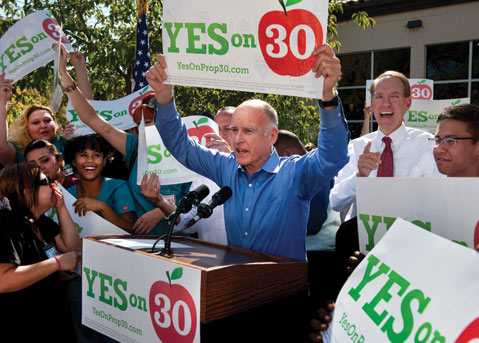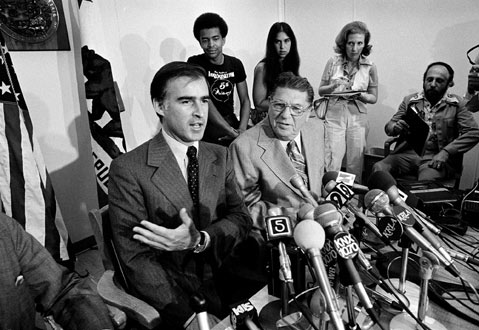Shades of Jerry Brown
How and Why Governor Moonbeam Returned to Earth

Governor Jerry Brown confronts a tangle of troubles rooted in the first two terms he held the office, half a lifetime ago. In putting Proposition 30 on the November ballot, the 74-year-old Brown not only has challenged Californians to make a high-risk policy decision that will shape our state for decades but has also set the stage for voters to pass judgment on the legacy of his epic political career.
One morning last spring, Jerry Brown addressed about a thousand businesspeople, burghers, lawmakers, and lobbyists at the 87th Sacramento Host Breakfast, an annual event that honors unity in a state bitterly divided by politics and taxes.
“For you students of classic drama — and I know there’s a few left — you read Aristotle’s Poetics,” said Brown, surely the only governor in America who, in a routine speech, would reference an ancient Greek treatise on the theory of tragedy.
“He talks about … three acts — there’s a beginning, there’s a middle, and the end,” Brown said. “We’re just beginning Act 2. The second is when … the protagonist is under pressure. Can he get out of the box he’s in? That’s always in Act 2.
“All right, you wait,” he added. “We’re going to get to Act 3 very soon.”
The Aristotelian allusion was to Brown’s own efforts to restore the fiscal integrity of state government. The key to his plan is a controversial November 6 ballot initiative to raise taxes for seven years, by about $8 billion a year, a measure that is anything but unifying.
As he bets his governorship on this high-risk, high-stakes showdown over taxes, Brown confronts the consequences of difficult decisions made when he first held the office half a lifetime ago — many in response to Proposition 13, the iconic 1978 measure that slashed property taxes in California, ignited a national taxpayer revolt, and ushered in an era of gridlock in Sacramento.
Brown was then 40 years old and had campaigned fiercely for Prop. 13’s defeat. But once it passed, he quickly became Prop. 13’s biggest advocate and moved swiftly to implement the legislation. Now 74, the governor grapples with a set of seemingly intractable dilemmas that trace back to that time.
California today is wracked by a feeble economy, widespread unemployment, substandard schools, a declining university system, and a business climate that CEOs have voted the nation’s worst. The governor won his third term in 2010 on a promise to end government dysfunction and restore the state’s fiscal health.
It is a historical irony that Brown, once a self-styled “born-again tax cutter,” now argues that the future depends on voters raising their own taxes. If the people turn him down, the defeat of his initiative will trigger billions of dollars in automatic cuts for state services and programs in the just-passed budget, with more than $5 billion of the burden falling on public schools. The coming verdict about his tax increase will not only serve as a referendum on his actions but also send a clear signal about what kind of government the voters want and how much they’re willing to pay for it.
“It’s a do-over — there’s a lot of unfinished business,” Sacramento Bee columnist Dan Walters, who began covering Brown in the 1970s, said of the governor’s third term. “His first governorship was a perpetual campaign. That’s the biggest difference — now he wants to govern.”

A Long, Strange Trip
Now the oldest chief executive in California’s history, Brown was the youngest of the century when first elected in 1974. Those who have followed his extraordinary political career may be forgiven for mistakenly believing that his third act passed long ago, that by now he must be well into his eighth or ninth, at least.
In addition to serving as California’s 34th and 39th governor, he was its 24th secretary of state, its 31st attorney general, and the 47th mayor of Oakland. The lifelong Democrat was also, for a brief turn, his party’s chairperson; and he made three failed bids for president. Not since Earl Warren, the late chief justice of the United States and the last California governor to serve three terms, has there been so enduring a state political figure.
Brown was born into politics. He is the third of four children and the only son of the late Edmund G. “Pat” Brown, an old-school Irish career politician who today is ranked among the most successful governors in state history. In contrast to his genial, backslapping father, aloof and intellectual Jerry at first rejected politics as shallow and phony in favor of studying for the Catholic priesthood. Three years of Spartan discipline and spiritual self-abasement at a Jesuit seminary convinced him to return to the secular world, whereupon he graduated from UC Berkeley with a degree in classics in 1961, and from Yale Law School in 1964.
Then he joined the family business, rising rapidly to the top. Brown’s election to the Los Angeles Community College District board in 1969 was the first of seven campaigns he ran in 12 years. After one term as secretary of state, he won the governor’s office as a political reformer the year Richard Nixon resigned because of Watergate.
Brown instantly became a crossover celebrity, a rock-star politician whose youth, bachelor status, Hollywood connections, philosophical musings, political lineage, and mastery of media symbols made him as irresistible to People magazine as to the New York Times.
More skilled at campaigns than governance, Brown in Sacramento was routinely disorganized, restless, and unfocused. He sometimes engaged deeply on issues, as when he brokered a landmark agreement between growers and farmworkers. More often, he practiced what he called “creative inaction.” Biographer Roger Rapoport recounts how Brown once scolded an aide for making a written record of a meeting: “The administration is like a moving river,” he said, “and minutes have no relevance to where we’ll be tomorrow.”
After a little more than a year in office, he decided in 1976 to run for president. A brief campaign sensation, he attracted large and excited crowds and won a few state primaries before Georgian Jimmy Carter, a far more methodical governor, beat him easily for the Democratic nomination. Back in the Capitol, Brown’s notoriously short attention span alighted on a new passion: the possibilities of space travel.
He sought state funding for a Syncom IV communications satellite, hired the astronaut Rusty Schweickart, and produced a splashy Space Fair coinciding with the first free flight of NASA’s space shuttle Enterprise. After his then-girlfriend, pop star Linda Ronstadt, jokingly called him “Moonbeam” in an interview, Chicago Tribune columnist Mike Royko dubbed him “Governor Moonbeam,” a moniker that stuck, undercutting his political credibility.
“We are but one speck,” he mused at the time, according to Rapoport in California Dreaming, his 1982 political history of the Browns. “We have to push forward, open up frontiers, new paths. … Where do people go when they can’t fit in? Space opens up possibilities. Besides, why not explore the universe? It’s interesting. Where does it end? If it ends, what’s on the other side? And if it doesn’t end, how can it go forever?”
Not long after, Proposition 13 brought him back to Earth.
A Memorable Celebration
On June 8, 1978, just hours after California voters passed his about-to-be-famous anti-tax initiative, a euphoric Howard Jarvis admitted a few reporters into his suite at the Biltmore Hotel in Los Angeles. And there he dropped his pants.
One journalist had noticed Jarvis limping and asked him why. He said he’d fallen in a TV studio a few days before. Not abstemious by nature, Jarvis appeared to feel the need to produce evidence, and so unzipped and lowered his trousers, showing off a pair of boxers as big as a jib and a bruise on his stern roughly the size of Rhode Island.
The display underscored the contempt the late Jarvis often exhibited toward the press and, by extension, the political class that opposed him. “Better government by the masses than government by the asses,” he liked to say. Then 74, Jarvis was a perennial candidate who worked for the Los Angeles Apartment Owners Association and was an antigovernment crusader who tried but failed to convince elected officials to heed his exhortations about property-tax relief.
At the time, big spikes in real estate tax bills were sapping the savings and retirement money of homeowners around California, forcing some to sell their homes. As a bubble sent prices soaring, county assessors used an autopilot system to calculate tax bills, pegging them to market value, regardless of how inflated the assessments were or whether a homeowner had any intention to sell. When homeowners looked to Sacramento for relief, the governor and legislators responded with inaction and half measures.
So Jarvis joined with Paul Gann, a Republican activist, to craft a constitutional amendment to fix the problem. Their measure, known as the Jarvis-Gann Initiative, would overhaul California’s property tax system: Real estate values would be rolled back to 1975 levels, with tax bills pegged to one percent of that amount. Future reassessments would occur only when property was sold; otherwise, annual increases would be capped at 2 percent. State government would decide how to implement these sweeping changes.
Across California, the plan would provide about $7 billion in tax relief — about $25 billion in today’s dollars — both to single-family homeowners, the most visible symbols of the problem, and to commercial property owners large and small, including the rental housing interests represented by Jarvis. The billions would be cut from local government and public school budgets from Yorba Linda to Yreka, with an uncertain impact that worried corporations, labor unions, and politicians alike, and led California’s establishment to oppose Jarvis-Gann.
Amid bipartisan warnings about calamitous fallout from the initiative, Gov. Brown emerged as its chief foil, calling it “consumer fraud, expensive, unworkable and crazy, the biggest can of worms the state has ever seen.” In the June election, 4.3 million voters thumbed their noses at the establishment, passing Prop. 13 by a 2-1 margin.
Then the governor got religion.

Comic Tax Relief
Three weeks after the landslide, Jerry Brown sat on the dais in the Capitol’s green-toned Assembly chamber, listening to Bob Hope crack wise. The venerable comic, there to receive a resolution marking his 75th birthday, packed his acceptance speech with one-liners about Prop. 13. “I want to tell you how great it is to return to Sacramento — the home of my money,” Hope began. “This is where they make the laws, and it’s only rarely that a victim gets to return to the scene of the crime.”
Warming to the task, he claimed he had “knocked on the door of the governor’s mansion and Howard Jarvis answered.” The real governor did not seem amused.
The appearance by Hope was one in a series of surreal scenes that hot summer in Sacramento, as politicians raced to enact Prop. 13. The emergency atmosphere contrasted with the way Brown and legislators had dithered over the simmering tax crisis before it boiled over in the June election. Facing a tough reelection race against Republican attorney general Evelle Younger, Brown suddenly became the biggest cheerleader for tax cuts, working energetically and enthusiastically to oversee a swift transition into the Prop. 13 era, earning the derisive nickname “Jerry Jarvis” from colleagues and the press.
“Center stage in the state’s big budget-cut drama, Brown kept himself on the front page while Younger’s political prospects sank steadily toward the obituary section,” Rapoport wrote. “The ever-flexible Governor … calmly engineered one of the state’s great flip-flops. And once set on his new course, he was able to dominate events.”
Brown was easily reelected a few months later. Soon he would launch a second campaign for president. But he would take dramatic actions in Prop. 13’s wake. Though effective in the short term, these actions would come to weaken California’s system of public finance and governance. “Jerry could be fairly faulted, not for changing his stand on Proposition 13, but for how he did it,” wrote Rapoport. “The proposition, while responding to a real need, was loaded with fiscal time bombs sure to detonate in the years ahead.”
The Ghost of Jarvis Past
And that future is now — in the form of perennial budget deficits, clashes over public-employee pensions and funding social welfare services, entrenched partisanship, and decades of decline in the quality of public education. “A pretzel palace of incredible complexity,” is how Brown recently described the problem.
At the heart of the matter is a structural budget deficit arising from the laws of arithmetic: California each year has spent more than it collects in revenue. As the state kept borrowing money to keep up, its once-impeccable credit rating sagged, driving interest costs ever higher. Over the last 20 years, Sacramento has several times resorted to IOUs to pay its bills. The template for the chronic crisis was drawn in Brown’s first term.
By the mid 1970s, the state government had amassed a multibillion-dollar surplus through the collection of income, business, and sales taxes. To shield local communities from the immediate impact of Prop. 13, the governor and Legislature used $7 billion in state money to bail out counties, cities, school boards, and special service districts.
Six months after redirecting much of the surplus to local governments, Brown in his second inaugural address proposed further tax cuts from the very state coffers he had just dipped into. The born-again tax cutter had seemingly taken the gospel to heart. Preparing to run again for president in 1980, he also called for a balanced budget amendment to the U.S. Constitution, a political gimmick that gained little traction in his unsuccessful challenge to incumbent President Carter. And it belied the fact that the state budget was not balanced.
State Department of Finance records show that in the budget year following passage of Prop. 13, California spent a billion more dollars than it collected in taxes. And structural deficits continued through the end of Brown’s governorship.
Pretzels, Prisoners, and Pensions
The bailout was only one issue affecting the course of California politics. Brown and lawmakers also built the foundation of the “pretzel palace” by centralizing power in Sacramento. “The shift started within days of Prop. 13’s triumph,” wrote journalists Joe Mathews and Mark Paul in California Crackup from the University of California Press, a 2010 detailed deconstruction of the state’s dysfunction.
“Using the new power given to it by Prop. 13, the Legislature divvied up the remaining property tax, giving most of it to counties and cities according to their prior spending levels. The state took over the primary duty for funding schools, which were now left with little tax revenue of their own, and it relieved counties of paying a share of some health and welfare programs.
“Where once there had been largely separate and relatively well-defined pots of revenue — one labeled ‘local,’ the other ‘state’ — there was now a single hydraulic money system, as vast as the state’s waterworks, with the Legislature controlling the sluices and valves.”
Over the years, the system has grown more tortuous, warped by frequent voter-approved initiatives that increased or earmarked spending. Brown’s recent push for “realignment” of services between state and county governments, most notably the costs of prisoner incarceration, is an attempt to unravel this perplexing network of overlapping jurisdictions.
Yet another source of Sacramento’s deadlock is the failure of bipartisan compromise. Once common, across-the-aisle deals have all but disappeared amid a constant standoff between Democrats and their public-employee union allies on one side, and Republicans and anti-tax absolutists on the other.
“Perhaps this is the reason why the public holds the state government in such low esteem,” Brown reflected in his 2011 inaugural speech. “And that’s a profound problem, not just for those of us who are elected, but for our whole system of self-government. Without the trust of the people, politics degenerates into mere spectacle; and democracy declines, leaving demagoguery and cynicism to fill the void.”
What Makes Jerry Run
During his 2010 race for governor, Brown was asked why voters should trust that, if elected, he wouldn’t run for president yet again. “Age,” he answered. “Hell, if I was younger, you know I’d be running again.” So why, then, in his seventies, did he want the same job he’d left during the disco era?
“I like this kind of work, and I think I could really make a contribution to clean up the mess in Sacramento,” he said. “I feel I’ve invested an enormous part of my life in understanding many of the issues that are alive today and urgent and very much call out for solutions. So on balance it struck me as something that I’d like to do … . I found myself — boy, I was very, very excited about this opportunity.”
“This is very different from 1975, when I was in a hurry,” he said, when asked what he had learned since then. “I was impatient,” he added. “I wanted to hit the ball out of the park, new ideas and bold appointments. Now what I’ve seen is things take time.”
“This is very different from 1975, when I was in a hurry,” he said, when asked what he had learned since then. “I was impatient,” he added. “I wanted to hit the ball out of the park, new ideas and bold appointments. Now what I’ve seen is things take time.”
California is greatly changed from Brown’s first terms. Technology has replaced the state’s old industrial economy. Population has grown more than 50 percent — to 37 million people; today, just 40 percent are non-Hispanic whites, with Latinos at 38 percent and heading toward majority status.
Politics is also different, far more polarized and toxic. Asked in 2010 how he would fight gridlock if he won, Brown said he would simply use sweet reason. “I’m going to be an apostle of common sense,” he said. “I will disabuse them of their ill-conceived predilections.”
Time for Plan B
Brown spent 2011 vainly pleading with Republicans for the few votes needed to bring his tax plan before voters. When apostolic common sense failed to move the GOP, he resorted to a signature-gathering effort to qualify the plan for November’s election.
Republicans now endorse his proposal for public pension reform, at a time when California faces vast unfunded retirement costs, and voters in several cities have overwhelmingly approved measures cutting benefits. But Labor has pushed back on pensions, and Democrats stalled his plan until the end of the legislative session, then passed a very watered-down version.
To his credit, Brown won some union salary concessions and convinced Democrats to back large cuts in favored liberal programs. Despite this, his latest budget is “balanced” only on hope, with projected revenues contingent on Brown’s initiative passing. This sets the stage for a decisive vote on the same fundamental question posed by Prop. 13: What is the proper scope and size of government?
Brown’s legacy is tied to that vote, and to California’s profound financial troubles, far more than to his abiding enthusiasms for such things as education reform and green energy. “Things that I was talking about 30 years ago — pension reform, renewable energy, completing the California water plan, high-speed rail — they’re right at the top of the agenda today,” he said recently.
“But we’re into instant gratification, get it done. If you don’t do it in two years, you’re a failure,” he added. “Life doesn’t work that way, at least from the point of view of somebody in their 74th year. It looks like things take longer, and now I’m kind of glad they do, because I still have something to do.”



